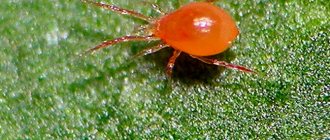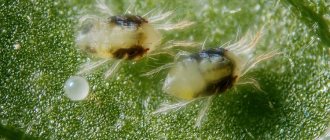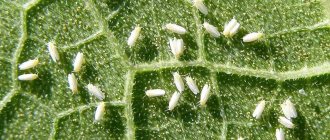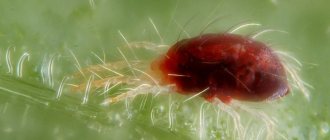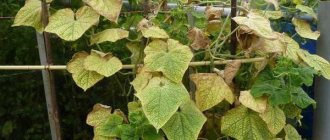Spider mite
The spider mite is a small insect (0.2-1 millimeter in length) with a bright red, greenish or brown body color. (Photo) The pest feeds on the juice of many crops; it is equally dangerous both in open ground and in a greenhouse or conservatory. The main danger comes not from the size of the insect, but from its numbers. Although spider mites have a short life cycle (males live no more than three weeks), they reproduce at an amazing rate. Over the course of a season, a female mite can lay from several hundred to several thousand eggs, which within a few days turn into larvae and begin to parasitize plants.
The female spider mite can exist in diapause for several months; in addition, it easily tolerates frosts of mid-latitudes; eggs in diapause remain viable for several years.
Why are spider mites dangerous?
Spider mites are a dangerous pest that also affects garden crops. Plants planted in a greenhouse fall into a special risk zone - the higher the air temperature and the lower the humidity, the more actively the pest multiplies.
It is difficult to notice it with the naked eye. The length of an adult does not exceed 1 mm. Spider mites are distinguished by their developed survival abilities - eggs remain viable for several years, remaining in diapause; adult individuals are not afraid of the frosts of the Urals and Siberia.
It is almost impossible to see spider mites on a plant due to its size
The pest becomes active towards the end of spring. It penetrates into the greenhouse in a variety of ways - through open doors and windows, with soil, and planting material. Spider mites feed on plant sap; the first signs of damage - yellowish-white dots - appear on the underside of the leaves. Then the affected specimens are entwined with thin “webs” along which the pest moves. Within 4–6 weeks from the moment of infection, the plant dries out and dies.
If nothing is done, the plant affected by spider mites will die quite quickly.
Prevention of the appearance of spider mites in the greenhouse is carried out in spring and autumn. If pest attacks cannot be avoided, more thorough treatment is required in the fall. They start it after harvesting. Calculate the time so that there are still 2-3 weeks left before frost.
Symptoms of spider mite infestation
As a rule, female insects begin to lay eggs in late April - early May. They do this mainly on weeds, and by the beginning of summer they move on to vegetables, berry bushes and ornamental plants. A mite can get into a greenhouse in a variety of ways: from the soil, with seeds and tubers, it can overwinter on frames or fly through open doors and windows.
It should be borne in mind that spider mites are among those insects that lead a secretive lifestyle. Therefore, look for signs of damage on the undersides of your plant's leaves. Small whitish or yellowish spots indicate places where the parasite pierced the leaf and began to suck out the vital juices. If you do nothing, you will soon notice the accumulation of cobwebs along which the pest moves in search of food. By that time, the leaves will begin to turn yellow, dry out and crumble, the plant loses its vitality and, as a rule, dies.
What does a spider mite look like?
This is a tiny insect measuring 1-2 mm. with piercing-sucking mouthparts. It comes in milky-transparent, yellow-green, orange or red colors. Female ticks can lay up to 400 eggs. In greenhouses they produce about 20 generations; mites live for 30–50 days. Arachnids begin to actively develop at temperatures from 12 degrees, feel great in conditions of 25 - 30 degrees Celsius, and humidity from 35 to 60 percent.
Spider mite
Attention! Tick eggs can be viable for up to 5 years!
A tick can get into a greenhouse in any way; even a summer resident can carry it on his clothes or tools. If an infection has occurred, you must meet the tick fully armed.
How to treat a greenhouse in the fall
If spider mites appear in the greenhouse, then you will have to carry out preventive work at least twice a year: in autumn and spring. Prevention does not guarantee the complete destruction of spider mites, but it significantly slows down the growth of its population and facilitates further control of the insect.
Prevention measures:
- After harvesting, it is necessary to remove or disinfect the soil in the greenhouse. Various preparations can be used to disinfect soil; a 2.5% formaldehyde solution has shown good effectiveness. More often, gardeners use a different method: they thoroughly clean the greenhouse of debris, sprinkle the soil with bleach (at the rate of 100 grams per square meter), and then dig up the ground. You can also spill the soil with any acaricidal solution;
- After removal or disinfection of the soil, the greenhouse must be treated. Thoroughly wash all frames, doors, and other structures with an acaricidal solution;
- Buy several smoky tobacco or sulfur bombs, light them and close the greenhouse tightly - the smoke should destroy the spider mite where it survived after washing; (Photo)
- After the checkers go out, do not open the greenhouse for at least another 5 days;
- Try to freeze the greenhouse. This must be done in severe frost. But at the same time, the soil must be free of snow.
Recommendations and tips for protection
We have given detailed instructions on how and with what to wash a polycarbonate greenhouse in the fall, but these measures are not enough to prepare for winter. It is also important to strengthen the structure, insulate it if necessary, and provide lighting.
If plants will be planted in the greenhouse for the winter in the fall, the foundation should be insulated with polystyrene foam boards, wooden panels, covered with film, and a mound of earth should be made. It is recommended to install a second layer of film, thin polycarbonate, inside. The air gap between the layers retains heat well.
The photo shows an example of insulating a structure in the fall
In regions with a harsh climate, you should consider heating the greenhouse in the fall: stove, electric, water. The easiest way to install ultraviolet heaters or fan heaters. For the full development of plants, do not forget to provide additional lighting; the set of lamps for lighting must completely duplicate the solar spectrum. To avoid damage to the greenhouse from heavy snow loads, vertical supports should be placed inside every 1.5-2 m.
Is it possible to get rid of spider mites? Of course, it is possible if you start fighting it in a timely manner. The fight against this pest includes a whole range of measures, including the use of potent drugs, folk remedies and agrotechnical measures. In most cases, pests are found in conditions of poor grooming, high plant density and the presence of weeds.
To carry out autumn treatment of a greenhouse against spider mites, it is recommended to use the following chemicals:
- Actellik in ampoules, as the most effective remedy.
- Plin-Plant and Etisso, in the form of sticks for digging into the ground.
- The drug BI-58 is a potent anti-tick drug.
No less effective are other drugs, such as:
- Aktofit.
- Apollo.
- Vermitek.
- Fitoverm.
- Bitoxibacillin.
- Colloidal sulfur.
As a rule, when there are still a few pests, it is enough to treat the plants every two weeks, and if there are quite a lot of them, then the frequency of treatment is doubled.
Natural ingredients are also suitable for fighting spider mites and repelling them. Such preparations are more suitable for use during the period of flowering, the appearance of ovaries, crop formation and harvesting. During this period, it makes no sense to use chemicals, since they can harm the plant and make the crop dangerous for consumption.
The following effective formulations exist:
- Hogweed infusion. Although this is a dangerous weed for humans, it has proven itself in the fight against parasites. The plant must be prepared, dried, crushed and poured with boiling water. For one bucket of water you need to take 1 kg of raw materials.
- A decoction of tomato tops. To do this, you need to cut up about 100 grams of green tomato tops and add 10 liters of water. After this, the container is placed on the fire and boiled for half an hour, after which the broth is filtered. Before use, 2 liters of broth are poured into a bucket and 30 grams of laundry soap are added to it. The solution is thoroughly mixed. This solution is effective not only against ticks, but also against aphids and slugs.
- Decoction of potato tops. To prepare the working solution you will need up to 1.5 kg of potato tops and a bucket of water with a capacity of 10 liters. The product is infused for about 3 hours, after which it is filtered. Plants in the greenhouse are sprayed from the bottom. As a rule, after such treatment, the larvae and adults die, but the eggs can survive. In this regard, vegetable growers recommend treating plants with this product once a week.
- Decoction of onion peels. Used in the fight against many pests. The decoction is prepared as follows: take half a bucket of husks and add 10 liters of hot water. The solution should sit for 24 hours, after which it is filtered and used to treat greenhouse crops. Before use, the infusion should be diluted with water in a concentration of 1:2.
- After harvesting, a series of agrotechnical measures should be carried out, including removing weeds and digging up the soil in the greenhouse. To minimize the possibility of such pests appearing in the greenhouse, all soil should be changed every 2-3 years. If it is not possible to replace all the soil, then at least remove the top ball of soil, about 10 cm thick. It is at this depth that parasites hibernate the most.
- Disinfection of soil in a greenhouse is an effective method of prevention. To do this, you will have to use the toxic product “Carbation”. The most optimal soil temperature for such events is 10 degrees, with an air temperature of 18 degrees and not lower.
- First of all, it is necessary to disinfect the greenhouse frames, consisting of various racks. They are treated with a stream of tap water and then with a soap solution. Particular attention should be paid to various crevices where parasites can hide.
- After harvesting, it is better to refresh the wooden greenhouse, for which you will have to use a mixture of whitewash and copper sulfate. The greenhouse must be processed at a temperature not lower than 15 degrees. It is better to treat the metal elements of the greenhouse with kerosene.
- The use of sulfur bombs is considered an effective method of combating various parasites, including spider mites. As a rule, sulfur bombs are used before planting plants in a greenhouse, otherwise the greenhouse crops will die.
- If no parasites or rodents are noticed in the greenhouse, then it is enough to wash all the utensils with a strong solution of potassium permanganate.
- It is equally important to deal with the destruction of weeds growing near the greenhouse. If this is not done, pests may move to the weeds to overwinter.
- An irresponsible attitude can lead to the fact that the greenhouse can become a breeding ground for many harmful insects. Having calmly overwintered in the greenhouse, they will be able to attack plants with renewed vigor.
We suggest you familiarize yourself with: Tomato varieties for a polycarbonate greenhouse: the best tomatoes with photos
| Name | Validity | Method of influence | Degree of toxicity |
| Apollo | 7 days | Hormone. Has an ovicidal effect | Slightly toxic |
| Akarin | 3-4 days | Enteric-contact | Moderately toxic |
| Neoron | 10-40 days | Enteric-contact | Slightly toxic |
Other drugs are also popular: Bi-58, Actofit, Vermitek, Flumite, Antiklesch. When using chemicals, you should use rubber gloves, special clothing and a respirator, and after processing, wash everything thoroughly.
Treatment with acaricides is carried out several times a season, with an interval of 7 - 12 days - approximately once a week the female mite lays eggs. The drugs should be changed from time to time, because spider mites adapt very quickly to the acaricide and do not respond to treatment. Treatments are stopped 10 days before harvest. And here comes the time to remember about non-toxic methods of influencing the pest.
| Name | Quantity | Cooking time and conditions |
| Marigolds, dried flowers | Fill ½ bucket with 5 liters of warm water | Leave for 2 days in a dark place, add 40 g household goods. soap |
| Fresh potato tops | 1.2 kg pour 10 liters of warm water | Leave for 4 hours |
| Tomato greens | 2 kg pour 5 liters of water | Boil for 30 minutes, add 20 g household goods. soap |
| Onion peel | 100 g per 5 liters of water | Leave for 5 days |
| Garlic | Grind 2 heads and add 1 liter of water | Leave for 5 days, strain and add 1 liter of water |
All solutions are used for spraying and, if there are not many plants, for wiping the leaves. Rubbing with alcohol or spraying with a solution of sulfur-tar soap gives good results. Plant infusions are used to repel:
- Dandelion. 30-40 g of crushed grass roots are infused in a liter of water for 4-5 hours;
- Yarrow. 700 g of dry raw materials are poured with a bucket of boiling water and left for 3 days;
- Horseradish. 1 kg of roots are crushed and infused for 5-6 hours;
- Sagebrush. 800 g of dry raw materials are poured with a bucket of water and left for 2 days. Then boil for 30 minutes and dilute with a bucket of water.
- Gray alder. Make an infusion of 2 kg of fresh leaves in a bucket of water for 24 hours. Then boil for 30 minutes. And again they insist for 12 hours;
- Blue blueweed, hogweed, datura vulgaris, nostalgia aconite, wormwood carpesium. So-called acaricide plants are used in a 15-20% solution: infused with alcohol and diluted in a concentration of 1:5. Treating even just a greenhouse once every 2 weeks can prevent the appearance of mites.
Remedies according to folk recipes can be used several times, while observing the dosage so as not to damage the plants.
Spider mites are a pest that causes disease. It is easier to prevent any disease than to treat it. Or create conditions that are unacceptable for the pathogen.
Tips and little tricks from experienced gardeners and amateur gardeners can be the very chance that will help you save your harvest:
- Excess nitrogen in the soil favors the proliferation of the pest, but it does not tolerate phosphorus;
- Spider mites love to infect young upper leaves, so inspect them first;
- If it is not possible to replace or disinfect the soil, then at least dig it up for the winter, this will destroy the pest eggs;
- To increase humidity, spray plants with a spray bottle, especially the underside of the leaves, where mites hide;
- When treating with folk remedies with the addition of soap, try to ensure that as little of the solution gets on the soil as possible, this can harm the roots;
- Do not use insecticides in the fight - at best they will be ineffective, at worst they will harm the plant. To destroy the pest, use acaricides and insectoacaricides;
- Alternate planting cucumbers with cabbage or tomatoes;
- Inoculate with phytoseiulus once every 20 days, or spread it in areas of greatest damage;
- A special variety of fungus, called entomophthora adjarian, is capable of completely exterminating spider mites in a greenhouse;
- Experienced summer residents, after the end of the cucumber season in July, clean and close the greenhouse, creating a temperature of up to 100°C, which can serve as disinfection;
- Use a solution of ammonia (1 teaspoon per 1 liter of water) or hydrogen peroxide (2 teaspoons per 1 liter) as a prophylactic agent.
Greenhouse treatment in spring
After winter, many gardeners take preventive measures again to prevent spider mites from entering their greenhouse. However, preventive measures must be carried out before the final completion of the harvest.
- Disinfect the soil again, if possible, do it with steam or pour boiling water over it;
- After covering the greenhouse with polycarbonate or cellophane film, it makes sense to place sulfur bombs and repeat the disinfection of the greenhouse premises. By the way, such checkers effectively help not only against spider mites, but also against other harmful insects, and also destroy parasitic fungi and their spores;
- Pay close attention to the seed - it may contain both live mites and their eggs. Treat the seeds, wash the seedlings and tubers - this activity will help prevent early infection with spider mites;
- When planting plants, follow the rules of crop rotation - do not allow crops that are particularly susceptible to spider mite invasion to be adjacent to each other;
- When planting and sowing tomatoes, cucumbers, peppers, eggplants or other vegetables, do not thicken the plantings - your plants should be well ventilated and ventilated;
- Create a microclimate in the greenhouse that is as uncomfortable as possible for spider mites: humidity from 85%, temperature up to 25C;
- Inspect the plants regularly, pay special attention to the underside of the leaves; as we have already said, spider mites are prone to a secretive lifestyle;
- Take fertilizing the soil seriously. Please note that the pest does not tolerate phosphorus in the soil, but an excess of nitrogen fertilizers has a beneficial effect on its reproduction.
Prevention of spider mites
To prevent the appearance of spider mites, it is enough to use a number of recommendations. For example:
- Do not leave weeds over the winter.
- Follow the recommended distances when planting plants.
- Maintain the recommended temperature and humidity conditions in the greenhouse.
- If single individuals appear, you should not delay treating plants using natural remedies.
- After harvesting, practice cultivating the soil and structural elements.
As a rule, an integrated approach to pest control gives the desired result. You should not ignore the advice of experienced vegetable growers, who claim that timely processing of the greenhouse in the fall will certainly result in a bountiful harvest next year. Fighting spider mites is a difficult process that takes a lot of strength and energy. Therefore, it is better to prevent the appearance of parasites using agricultural technology, chemicals and folk remedies.
Biological control methods
Fortunately for gardeners and flower growers, spider mites have many natural enemies. Some of them feel great in mid-latitudes and are capable of, if not destroying, then significantly reducing the pest population in your greenhouse.
Phytoseiulus. A predatory acarifage, with a bright red coloring, which is a natural enemy of the spider mite and is capable of completely destroying its population in a greenhouse. The insect can be ordered in specialized stores. Phytoseiulus does not live long (about 4 weeks), but during this time it manages to destroy many parasites and produce offspring. Phytoseiulus effectively protects cucumbers, tomatoes, peppers, eggplants, other vegetables, berries and flowers from spider mites. (Photo)
Phytoseiulus
Amblyseius Swirsky. Svirski also belongs to the category of predatory acarifages; it feeds on spider mites and is successfully used to protect against the parasite in many countries around the world. An important advantage of this predatory insect is the fact that it does not enter diapause, which means it can protect your greenhouse throughout the year.
Amblyseius Swirsky
Gall midge Afidimisa. A small predatory mosquito happily destroys spider mites at all stages of their development. Note that Gallitza successfully controls a wide range of pests; the insect is able to reproduce both in a greenhouse and in open ground. According to biologists and gardeners, the predator does not leave the greenhouse until the mite is completely destroyed. Gallica Afidimiza is supplied in small containers; biological material can be ordered in most specialized stores.
Gallica Afidimisa
Problems of controlling spider mites
When trying to destroy pests in a country house, in a greenhouse or on open ground, you may encounter serious problems that will prevent high-quality and effective control:
- Difficult detection of the problem, although this is precisely what is most important for effective “war”;
- Rapid reproduction of the mite, the population of which grows much faster than many summer residents poison the pest;
- The ineffectiveness of many drugs, as well as the high ability of insects to adapt;
- The need for frequent treatments, since the tick cannot be killed in 1-2 times, especially if the females have already laid thousands and thousands of eggs;
- The need to completely destroy the population, otherwise you can get a huge number of insects adapted to the drugs used;
- Cobwebs are a way to move insects, as well as excellent protection from moisture and solutions with effective drugs;
- The need to use loading doses, and often, novice summer residents use the products sparingly;
- The need for high concentrations of drugs, which is dangerous for the health of people and animals, as well as contamination of the fruits of cultivated plants.
Folk remedies in the fight against spider mites
Many gardeners and gardeners try to avoid the use of agrochemicals in their greenhouses; they give preference to relatively effective, and most importantly safe, folk remedies. In most cases, such drugs are used during greenhouse maintenance work to prevent spider mites.
Tobacco decoction. To prepare this product, you need to purchase 200 grams of tobacco or shag (you can also gut 4-5 packs of cheap strong cigarettes).
The raw material is poured with three liters of hot water (or boiling water), then infused and cooled for 30-36 hours. After this, the mixture is boiled over low heat for two hours. Cool the infusion and strain it through several layers of gauze, and then add clean water to make five liters of decoction. To increase adhesion, add 50 grams of solid or liquid soap and stir the liquid. Tobacco decoction is used for spraying plants, watering the soil and washing leaves and stems affected by spider mites.
Spider mites in a greenhouse
The small pest, whose length rarely exceeds 0.1–0.2 mm, is almost impossible to see with human eyes, but the damage it causes is immediately visible. The insect settles on the back side of the leaf blade, damages it with its proboscis, drawing out juices. In this case, chloroplasts are destroyed and the process of photosynthesis in damaged cells stops. The leaves become covered with whitish-yellow spots, then gradually dry out completely.
Spider mites are very small and difficult to see without magnification.
The plant itself on which the spider mite has settled (and this creature reproduces extremely quickly) weakens, is less resistant to diseases and other parasites, stops developing and dies . Its growing season is greatly reduced, which inevitably leads to significant crop losses.
Chemical methods of protecting a greenhouse from spider mites
If prevention and treatment with folk remedies did not lead to the destruction of spider mites in the greenhouse, do not panic. Over the past decade, scientists have developed many acaricides that are quite effective at controlling spider mites and other harmful insects. At the same time, it should be recalled that some chemicals have a high degree of toxicity. Before using such products, you must carefully read their description and user instructions.
BI-58. A new systemic contact universal insectoacaricide that effectively controls a wide range of pests, including spider mites. The chemical acts when it comes into contact with an insect, and it also penetrates into the plant, which leads to the death of sucking and gnawing parasites. Bi-58 has a prolonged period of protective action (15-20 days). Please note that Bi-58 is dangerous for beneficial insects, especially bees. Entry into the greenhouse for a long time is permitted 96 hours after using this acaricide.
BI-58
Vermitek
Plant Pin
Vermitek. An enteric-contact insectoacaricide penetrates inside the plant very quickly (within two hours) and effectively destroys leaf-sucking and leaf-gnawing pests. At the same time, it is practically harmless to predatory insects, which are bred in greenhouses to protect against spider mites. Vermitek is highly selective; it does not interfere with photosynthesis and does not have a phytotoxic effect on plants. With low toxicity, a long period of protective action is observed - up to four weeks, which allows reducing the number of crop treatments.
Plant Pin. The product comes in the form of sticks that are stuck into the ground near the roots of the plant. When watering the greenhouse, the sticks dissolve in the ground, enter the root system, stems and leaves of the plant, leading to the death of spider mites and other pests. Plant-Pin demonstrates particularly high effectiveness in early spring, when most female ticks are just emerging from diapause.
How to treat a greenhouse against spider mites in spring
Traditional methods of control are good for small infections. But when the spider mite completely dominates the greenhouse, then it is worth resorting to more radical methods. To do this, they use chemicals, which, unfortunately, have a detrimental effect not only on parasites, but also on the crop.
Effective drugs:
- "Fitoverm" - suitable for seedlings and protection of indoor plants;
- “Benzyl benzoate” – affects the entire available population of ticks;
- "Actellik" is an effective drug that will effectively destroy pests;
- “Bi-58” is a fairly powerful tool, used when other methods have proven to be completely ineffective;
- “Kleschevit” – gives a good result when processed;
- "Aktofit" - should be used in clear weather;
- "Vertimek" is often recommended to poison spider mites.
Treatment involves abundant watering before applying chemicals. This is done to prevent stress or burns. It is also worth adding 50 g of potassium soap to the solution. This will increase processing efficiency.
The main thing is to maintain the concentration of chemicals so as not to ruin the crops. The first treatment should affect not only adults, but also larvae. After 1.5 weeks, a second treatment is carried out. But other drugs are used.
Advantages and disadvantages of using chemicals
Advantages:
- Wide selection of chemicals;
- Effectively affects ticks at all stages of its life cycle;
- Combines protective and stimulating effects;
- They have a prolonged protective effect.
Flaws:
- Require compliance with safety regulations and the use of personal protective equipment;
- Some drugs are addictive to insects and cannot be used for several years in a row;
- There are a large number of counterfeits of original products on the market.
Spider mites in a greenhouse measures
Before starting a new gardening season and planting plants in the greenhouse, it is necessary to prepare it thoroughly in order to minimize the risk of plantings being damaged by spider mites:
- All structures must first be thoroughly washed with a brush with warm water and any detergent soap, paying special attention to joints, corners and other secluded places. Rinse with water from a hose.
- All elements of the structure are treated with a strong dark red solution of potassium permanganate, not forgetting about equipment and various devices (stakes, ropes, etc.).
- If possible, replace the top layer (15–20 cm) of soil or pour boiling water over the soil. To enhance the effect, cover with plastic wrap for 2–3 days. The procedure is repeated three times. You can use a household portable steam generator.
- Disinfect the greenhouse:
- chemicals;
- smoke bomb;
- folk methods.
In spring, the greenhouse must first be thoroughly washed
Chemicals
The greenhouse, both inside and outside, as well as the greenhouse soil, are thoroughly sprayed with one of the following compositions:
- colloidal sulfur (80 g per 10 liters of water);
- copper sulfate (5%);
- Bordeaux mixture (3%);
- bleach (0.4–0.6 kg of lime is poured into a bucket of water, left for 3–4 hours);
- specialized acaricidal agents (Kleschevit, Kabofos, Actellik, BI-58, etc.), working solutions are prepared according to the attached instructions.
Smoke bomb
Treatment of greenhouses and greenhouses with sulfur smoke bombs is effective. The gaseous sulfur dioxide released during this process penetrates into the narrowest and most secluded places, into any holes and crevices, killing arthropods and their larvae even in the ground.
The technology is as follows:
- Since sulfur compounds corrode metals, all metal elements must first be protected by coating them with any thick lubricant (solidol, etc.).
- Seal the room as much as possible, carefully sealing all cracks and holes with sealant or tape.
- The required number of checkers are placed on non-combustible bases (sheets of metal, bricks, etc.).
- Light the wicks, starting from the farthest edge and approaching the entrance.
- They leave, closing the doors tightly.
- The greenhouse is left closed for 2–3 days, then torn off and thoroughly ventilated for at least a day.
All work must be carried out with caution and strictly following the instructions, as well as using personal protective equipment (gas mask, protective gloves, etc.).
Fumigating a greenhouse with a smoke bomb gives a good effect
To increase efficiency, it is recommended to lightly wet the walls and ceiling before starting treatment. By reacting with water, sulfur dioxide is converted into weakly concentrated sulfuric acid, which has disinfecting properties.
Folk remedies
Some gardeners are afraid to use chemicals to treat the greenhouse, preferring traditional methods that have been proven by time and generations:
- Infusion of onion peels. Half a bucket of onion peels is poured into 10 liters of boiling water and left for 2-3 days under a closed lid. After filtration, the entire structure is sprayed.
- Tansy decoction. Dried tansy (200–300 g) is boiled in a bucket of water for about 15 minutes, cooled, filtered and used for processing.
- Infusion of citrus peels (orange, lime, tangerine, lemon). The crushed peel (1 kg) is infused for 5 days in 3 liters of water. The working solution is prepared from ½ cup of infusion and a bucket of water.
- Garlic infusion. Remove scales from two large heads, chop finely and add a liter of warm water. After steeping for 5 days, strain and dilute with water in half.
Video: spider mites in a greenhouse
Spider mites are tenacious and can sometimes be difficult to get rid of. The effectiveness of the measures taken directly depends on the speed of response, the competent selection of means of control and their correct use. In some cases, you can get by with basic preventive measures and compliance with the rules of agricultural technology.
- Author: admin
Rate this article:
- 5
- 4
- 3
- 2
- 1
(4 votes, average: 3.5 out of 5)
Share with your friends!
